|
Maintaining Your Garden
All gardens require maintenance. Weather, weeds, and wear and tear all take their toll on both plants and garden structures. Even the most self-sufficient plants need occasional cleanup - removal of dead or unhealthy growth through selective pruning, shearing, or dead-heading (clipping off spent flowers and leaves). If the garden is regularly maintained, it will continue to be healthy and water efficient. However, if you are hard pressed for time, consider hiring a licensed landscape professional to maintain your garden.
A truly effective maintenance routine is one that is year-round. The various tasks are spread out over the months, making them small, and manageable. It is sometimes overwhelming when spring or summer arrives and everything must be done all at once.
Below are maintenance tips for each month:
January
| • | Plant bare-root shrubs and trees. |
| • | Prune trees and shrubs while they are dormant. |
| • | Wait until the flowers of spring-blooming shrubs fade before pruning. |
| • | If maintaining a lawn is not appealing, plant a water-thrifty ground cover. See Plant Lists found under Plants on the Main Menu for ideas. |
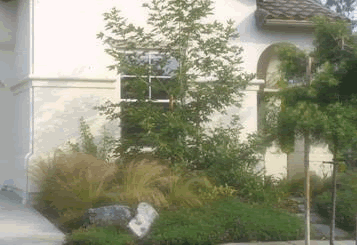
Ornamental grasses can be low maintenance and water
thrifty, making them a good choice for a ground cover.
| • | Sharpen shovels and pruning tools. Use steel wool to remove rust. Sand wooden handles and apply linseed oil to protect the wood. Apply a band of bright-colored, water-resistant paint on handles to make the tools easier to locate if left in the garden. To keep long-handled tools rust-free, store them in a bucket filled with sand saturated with mineral oil. |
February
| • | Remove broken tree limbs if they pose a danger. Otherwise, wait until the weather warms to have them removed. Plant spring-blooming perennials and summer-blooming bulbs. Remove slug and snail eggs by hand, or use traps or commercial bait. |
| • | Begin elimination of weeds while they are still small. |
March
| • | Fertilize or plant spring-bloomers with a complete fertilizer. |
| • | Plant summer-blooming perennials and water thoroughly. Apply a low-nitrogen fertilizer. |
| • | When new growth appears on established perennials, cut back dead growth. |
| • | Check and maintain irrigation system. Flush out or scrub sediment from filters and from each end of line. Check screens for algae. Make sure all emitters are functioning. Clean or replace clogged ones and check for and repair leaks in lines. |
April
| • | Feed trees and shrubs with a complete fertilizer. |
| • | Plant water-conserving perennials. |
| • | Check new growth for aphids and eliminate with a blast of water from a hose nozzle. |
| • | Clean bird feeders with hot, soapy water. Allow to dry thoroughly before refilling. |
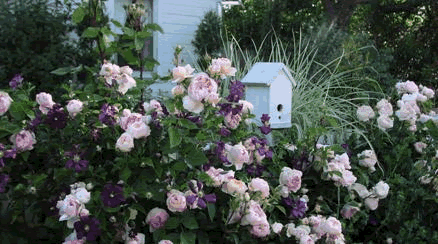
Design: Michelle Derviss Landscapes Designed
A bird feeder amidst spectacular roses.
May
| • | In windy areas, stake young trees. |
| • | Plant warm-season vegetables (be sure that the chance of the frost has passed). |
| • | To help control aphids, mealy bugs, scale, and other soft-bodied insects, buy and release lacewings, a beneficial insect that feeds on a variety of garden pests. For more information visit the Pest section. |
| • | Provide fresh drinking water and food for beneficial insects such as butterflies. |

The Buddleja (Butterfly Bush) blossom attracts butterflies.
June
| • | Reschedule your irrigation timer and make sure that newly planted trees and shrubs are kept moist. |
| • | Deadhead perennials through the summer months to keep them blooming. |
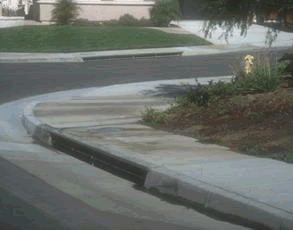
Irrigation water run-off harbors plant fertilizers, oil,
and other harmful toxins to people, fish, and wildlife.
July
| • | During these hot summer months, water plants at night or in the early morning hours. |
| • | Check for spider mites and treat if necessary. |
| • | Harvest tomatoes to encourage continued fruit. Feed tomatoes with a moderate-nitrogen fertilizer. |
| • | Pinch back the growing tips of herbs. |
| • | If you have a lawn, purchase an electric mower; most have a mulching feature that leaves finely shredded grass in place on the lawn, so no raking or bagging is necessary. For more information go to to the BAWSCA/Stopwaste.org mulch guide at: http://www.bawsca.org/docs/mulchguide-2006_BAWSCA.pdf. Keep the mowing height high during summer’s heat. Mow when the grass is about a third taller than the recommended height. Aerate the lawn if needed. |
| • | If you have a compost pile, keep it moist during dry spells. Make sure to keep a layer several inches deep of dry material on the top to prevent flies. |
August
| • | Take advantage of warm, dry weather to repair loose gate hinges or wobbly fence posts in preparation for fall and winter rains. |
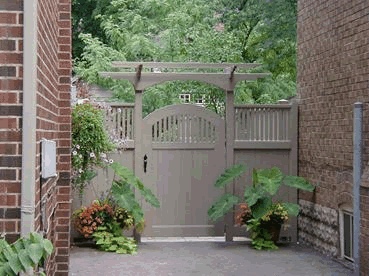
Take advantage of warm, dry weather to repair fencing, gates
and posts.
| • | Replenish or place mulch where needed. |
| • | Change irrigation schedule in the middle of the month to gear down for Fall. |
September
| • | Fertilize established plants, except for California natives or Mediterranean type plants. |
| • | Rake fallen leaves and place in compost pile, green-waste recycling cart, or use as mulch in flowerbeds. |
| • | Plant spring-blooming bulbs. |
October
| • | Plant perennial trees and shrubs from nursery containers. If perennials are crowded, divide them. If they are straggly, cut them almost to the ground. |
| • | Remove vegetable plants past their prime and compost or recycle of properly. |
| • | If you like garlic, now is the time to plant it. |
| • | Reschedule your irrigation timer to reduce the watering. Test your soil now if you suspect it is deficient in nutrients. The pH may require adjustment. |
| • | Make a complete inspection of your porch, patio, and other exterior structures that may be subject to damage caused by insects, animals, or moisture. |
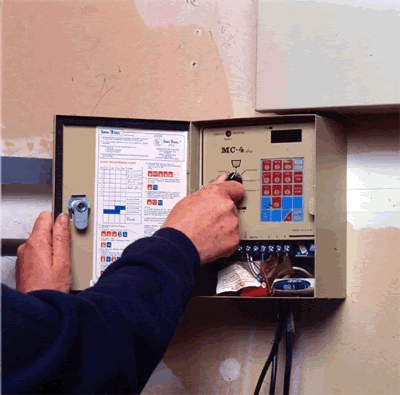
By October lawn areas only need half the number of watering days they needed in July.
November
| • | Place or replenish mulch around trees and shrubs. |
| • | Plant a nitrogen-replenishing cover crop. |
| • | Recycle plant containers. |
| • | Stock up on landscape fabric, garden tools, and irrigation systems that are usually on sale at garden centers and nurseries during this time. |
December
| • | Lightly prune evergreens for holiday decorating. |
| • | Moss on pathways, decks, and stairs can be dangerously slippery; lightly scrub with steel brush to remove. If steps, or ramps, are very slick, nail thin strips of asphalt roofing material on them to provide better traction. |
Other maintenance topics:
Lawn
Mulch
Pests
Pruning
Irrigation Maintenance
|
